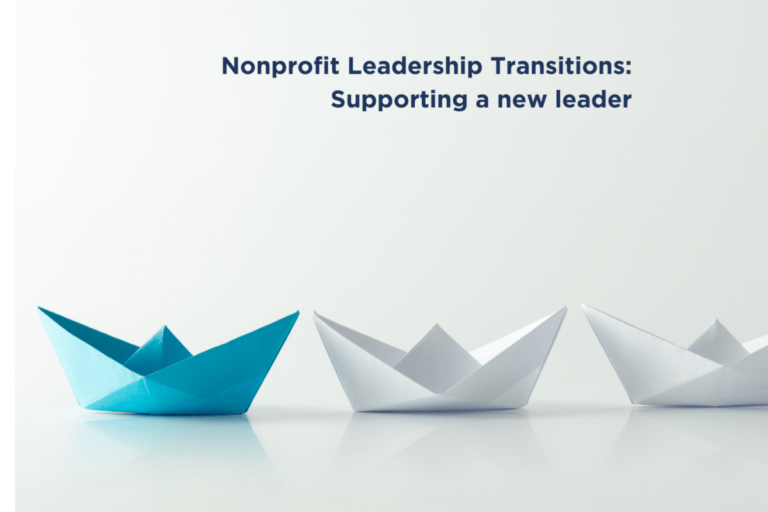Nonprofit Leadership Transitions, Part 3: Supporting a New Leader

Your organization might not be facing a nonprofit leadership transition today, but part of your board’s role is to have some level of preparation for whenever transition occurs. In our first two posts of this series, we talked about types of nonprofit leadership transitions an organization might encounter, and what we have seen during a transition, both good and bad.
In our final post of this series, we wanted to offer a few important reminders and discuss how important it is to support a new leader as they transition into their role.
As you consider a nonprofit leadership transition:
- Determine the role of your transition team. They can help prepare the board for the transition, guide the search and hiring phase, and lead short-term orientation of the new leader. Or some of these roles may be handed over to another group; for example, the executive committee may take the lead on the short-term orientation.
- Support your board’s readiness with training, generative conversations, and other capacity building. This preparation can center on organizational strategy, desired leadership traits, financial health, or other topics critical to the organization’s success and stability as it welcomes a new leader. When done well, what you learn in this preparation phase carries forward to the onboarding phase with your incoming leader.
- Always have an emergency succession plan with key roles, relationships, upcoming decisions or inflection points, and delegated decision-making authority. This helps maintain continuity during a transition, especially if it takes longer than expected.
- Communicate with stakeholders to inform them of the upcoming change in leadership. You may begin transferring relationships, engaging their support if needed, and reassuring them of your organization’s capacity to continue serving the community.
- Be clear on the role of your departing leader. Sometimes there is an overlap between the incoming and outgoing leaders, and the exiting leader can participate in orienting the new leader. Other times the exiting leader departs before the incoming leader arrives. In this situation, the board should take the lead in orienting the incoming leader. In either case, clarity around the role of the departing leader is a key element in the transition.
Supporting a new leader
A leadership transition requires time and energy from your board. While it can lead to some board fatigue, make sure not to abruptly stop the transition efforts after the hire has been made. (Note: fatigue is real – this is one reason a transition team may hand off the onboarding responsibilities to another group.)
As you consider onboarding and supporting your incoming leader:
- Adjust your board’s expectations – of your incoming leader and of yourselves. New leaders need time to build internal and external relationships and learn about the organization’s operations. Your board needs time to develop its partnership with the new leader. You both have a learning curve that requires you to adjust your expectations compared to how things worked with the previous leader.
- You should expect to provide a heavy amount of support to your incoming leader. In addition to learning the organization, they may be new to the role of an executive director, or they may be new to the part of the nonprofit sector in which your organization lies. They may also have specific professional development needs that require training or a restructuring of responsibilities within the organization.
- Board members can exercise their ambassadorship and support the incoming leader by connecting and building relationships with external allies, funders, and other key stakeholders.
- Do not forget what you learned during the preparation phase of your transition. Boards that have looked at their strategic direction, financial health, board roles, and other organizational topics can use what was learned and explored to provide context to the incoming leader.
- Boards often want to hire someone who is Black, Indigenous, or a Person of Color (BIPOC), but the right support for their transition is not in place. Boards need to examine their own biases and willingness to adapt the partnership with their new leader. Hiring a BIPOC leader into a historically white-led organization where a board wants to continue to conduct business as usual can be an unwelcoming environment and lead to the new leader departing, causing harm and disruption to both the new leader and the organization.
Leadership transitions are exciting opportunities for organizational transformation. The board’s leadership is imperative to a successful transition and a continued advancement of the organization’s mission. We hope that this series is helpful as you prepare to or are currently navigating a transition.
This blog is part of a three-part series by Mario Hernandez and Amanda Ziebell Mawanda. Read parts one & two.


